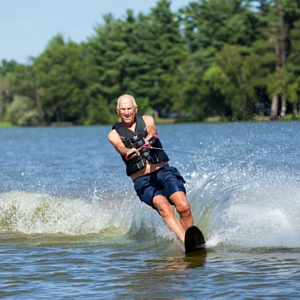Water Skiing Tips

Here are a few basic guidelines to keep you safe while having fun on the water.
Check Out the Location
For starters, think about the body of water. Is it big enough to accommodate skiing? It needs to be at least 2,000-3,000 feet long. Safe skiing also requires a depth of at least five feet of obstacle-free water so skiers don't drag their skis during starts or hit bottom during a fall. There also needs to be enough room for all of the boats, jet skis, and other skiers on the water to have at least 100 feet of open space in all directions—and a 200-foot skiing corridor.
So the water's big enough and deep enough and you're ready to go. Before you do, get familiar with the area. Are there buoys, stumps or pilings? If you're not sure, look at charts of the area, or better yet, get in the boat and take a drive through the skiing area.
Check the Weather Forecast
Water and electricity don't mix well, so it's best to put up the skis at the first sound of thunder. In fact, any condition where it's hard to see, like fog or rain or at night, is best left to the Loch Ness Monster than to water skiers.
Check Your Gear
In any boating activity, it's not just Mom who wants you to wear a life jacket. The U.S. Coast Guard does, too. Luckily, there are lifejackets that allow increased range of motion for your arms that still pass Coast Guard muster.
Check Your Signals
Okay, you've got the water conditions and life vest down. Now make sure you've got someone with experience in the boat watching out for you, and that you know how to communicate with them through some standard hand signals. If you're having difficulty in the water, you'll be able to let the driver know.
Note to Skippers
If you're towing a skier, it's important to steer clear of crowded beaches and swimming areas, and to turn the engine off when approaching a skier in the water.
Find more safety tips at the National Safe Boating Week or learn more about our boat and personal watercraft coverage by contacting your local Shelter agent.
One last thing: Don't forget the sunblock.
-
Boat Safety Training
 Learn More
Learn MoreNothing ruins a fun day on the lake quite like a boating accident. Taking a training course can help prepare you.
-
Boat Care 101
 See How
See HowOwning a boat, hitting the waves and water skiing is exciting. Don't forget how to take care of your boat.
-
Boat Insurance Covers More than Just Your Boat
 See Details
See DetailsBoating season has arrived. Don't sweat your suntan lotion off worrying about a water mishap. That's where we come in.
